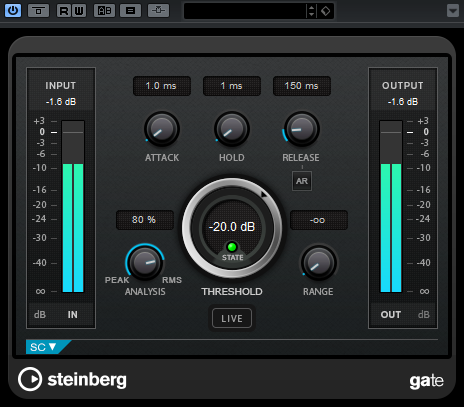Gate
Gating, or noise gating, silences audio signals below a set threshold. As soon as the signal level exceeds the threshold, the gate opens to let the signal through.
|
Cubase LE |
Cubase AI |
Cubase Elements |
Cubase Artist |
Cubase Pro |
Nuendo |
|
|---|---|---|---|---|---|---|
|
Included with |
– |
– |
– |
X |
X |
X |
|
Side-chain support |
– |
– |
– |
X |
X |
X |

- Attack (0.1 to 1000 ms)
-
Sets the time after which the gate opens when it is triggered.
NoteDeactivate the Live button to make sure that the gate is already open when a signal above the threshold is played back.
- Hold (0 to 2000 ms)
Determines how long the gate remains open after the signal drops below the threshold level.
- Release (10 to 1000 ms or Auto mode)
-
Sets the time after which the gate closes (after the set Hold time). If Auto Release is activated, Gate automatically finds the best release setting for the audio material.
- Threshold (-60 to 0 dB)
Determines the level where the gate is activated. Signal levels above the set threshold trigger the gate to open, and signal levels below the set threshold close the gate.
- State LED
Indicates whether the gate is open (LED lights up in green), closed (LED lights up in red) or in an intermediate state (LED lights up in yellow).
- Analysis (Pure Peak to Pure RMS)
Determines whether the input signal is analyzed according to peak or RMS values, or a mixture of both. A value of 0 is pure peak and 100 pure RMS. RMS mode operates using the average power of the audio signal as a basis, whereas Peak mode operates more on peak levels. As a general guideline, RMS mode works better on material with few transients such as vocals, and Peak mode works better for percussive material with a lot of transient peaks.
- Range
Adjusts the attenuation of the gate when it is shut. If Range is set to minus infinite
 , the gate is completely shut. The higher the value, the higher the level of the signal that passes through the shut gate.
, the gate is completely shut. The higher the value, the higher the level of the signal that passes through the shut gate.- Live
If this button is activated, the look-ahead feature of the effect is deactivated. Look-ahead produces more accurate processing, but adds a specific amount of latency as a trade-off. If Live mode is activated, there is no latency, which is better for live processing.
Side-Chain Section
- Side-Chain
Activates the internal side-chain filter. The input signal can then be shaped according to the filter parameters. Internal side-chaining is useful for tailoring how the gate operates.
- Monitor
Allows you to monitor the filtered signal.
- Center (50 to 20000 Hz)
If the Side-Chain button is activated, this sets the center frequency of the filter.
- Q-Factor
If the Side-Chain button is activated, this sets the resonance or width of the filter.
- Filter buttons (LP, BP, and HP)
If the Side-Chain button is activated, you can use these buttons to set the filter type to low-pass, band-pass, or high-pass.
If side-chaining is supported, the gate can also be controlled from another signal source via the side-chain input. If the side-chain signal exceeds the threshold, the gate opens. For a description of how to set up side-chain routing, see the Operation Manual.